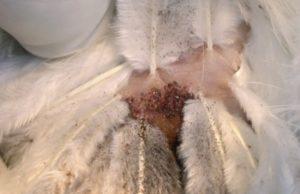17 Ways to Get Rid of Pereeding in Chickens
One of the most dangerous avian parasites are feathereaters. With the advent of harmful chicken lice, the egg production rate drops. Chickens lose weight and look bad. Pest infestation can even lead to death. In this regard, it is necessary to monitor the condition of the birds.
Content
Downy-eaters: photo
Description of the pest
Name: Downy-eater
Latin: MenoponidaeClass: Insects - Insecta
Squad: Lice and lice - Phthiraptera
 | Habitats: | all over, around poultry |
 | Dangerous for: | own birds |
 | Facilities destruction: | insecticides, folk methods |
Peroeds are outwardly similar to lice. The length varies from 1,5 to 3 mm.
The color is yellow-brown, there are dark spots. The head is triangular in shape. Mouth apparatus gnawing type. The body is elongated and flat in shape with segments.
On the limbs there are claws with which the parasites are attached to the body. They are distinguished by agility and speed of movement. The color merges with the color of the skin of birds. In this regard, pests are difficult to detect.
Life cycle
- The life cycle of an insect is one month. The optimum temperature is from 25 to 30 degrees Celsius, and humidity from 70 to 80%.
- Pests reproduce at a tremendous rate. A female can lay up to 10 eggs per day. During the life cycle, up to 120000 individuals can appear from one pair.
- Up to 10000 parasites can live on the feather covers of one bird. They use the top layer of the skin, the base of the feathers, dead skin particles.
- Pests are very tenacious and can adapt to any conditions and temperature conditions. The females lay eggs that take 2 to 3 weeks to mature.
In a short period of time, parasites can cause enormous damage.
Signs of perioditis
The appearance of the first symptoms of pest damage may not be noticed. It is difficult to notice a small population of downy eaters; they actively move around in the chicken coop already with a massive infection. Initial signs include:
- anxiety for no reason;
- loss of appetite;
- intense pinching of feathers;
- inflamed skin;
- weight loss;
- poor development of chickens;
- dermatitis;
- eye inflammation.
How to deal with feathering
Infection is fraught with a decrease in egg production up to 20%. Downy eaters affect mainly young chickens. Much less often they live on mature birds.
- conduct a test for mallophagosis, with a positive result, do not let the bird out of the cage;
- get rid of wooden poles, replacing them with plastic ones;
- disinfect the habitat in the room;
- use an additional cell during the treatment period;
- be sure to ventilate the room before populating the chickens.
Processing methods in the chicken coop
It is necessary to disinfect the poultry house even with one infected chicken. It is necessary to act quickly so that the parasites do not spread to other birds. Suitable for this:
- Cyodrin - water 25% composition;
- Entobacterin or Oxalate - 2% emulsion;
- Chlorophos - aqueous 0,3% -0,5% suspension;
- Karbofos - refers to insecticides.
Previously, dichlorvos was used for these purposes. However, its use involves the poisoning of laying hens. This substance is forbidden to be used in the fight against pereedy.
Substances from veterinary pharmacies
Of the veterinary drugs, it is worth noting the action of Bars, Insectol, Frontline, Neotomazan.
With a small number of chickens, a lice remedy is suitable - Nyuda spray.
But these compounds will not be able to cope with laid eggs. In this regard, the treatment must be repeated after a week. During processing, it is recommended to tie the beak so that the chickens are not poisoned by insecticides.
Folk methods of dealing with pests
Folk methods have been tested for a long time and are no less popular than chemical preparations.
| Water, vinegar, kerosene | The composition is shaken and applied to the feathers of birds. Only suitable for adult chickens. |
| Benzene, kerosene, ammonia in a ratio of 1:1:1 | The composition of benzene with kerosene and ammonia - it is forbidden to apply to young birds. |
| sand and ash | The amount of sand and ash should be the same. You can add chlorophos to enhance the action. Such a composition is placed in places for walking chickens. |
| Camomile | Chamomile infusion is a universal remedy for young animals. It is rubbed into feathers. |
| Sagebrush | Ground dry wormwood - pests cannot stand it. Can be used for chickens. |
| Hedgehog and hellebore | The ground branch of the barnyard and the root of the white hellebore is toxic. The powder is carefully applied, dusting the feathers. |
| sulfur checkers | Fumigation with a sulfur bomb is the most effective method. |
| Tansy or wild rosemary | Fresh plants are used as chicken coop bedding. |
preventive measures
A few tips to prevent breakouts:
- The chicken coop must be clean. It is necessary to replace dirty bedding, treat walls, feeders, nests with boiling water;
- exclude contact with wild individuals;
- fed with a balanced diet with vitamins, calcium, shells;
- observe the rules of personal hygiene, work in separate clothes and shoes;
- periodically inspect the bird.
Conclusion
Every poultry farmer dreams of healthy pets. In this case, the chicken is able to carry many eggs and make a profit. Even in individuals with good immunity, parasites can appear. Be sure to take preventive measures to protect against their invasion. When the first pests are found, they begin to fight them with folk or chemical means.
Previous

